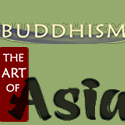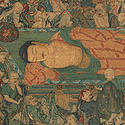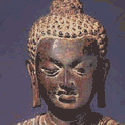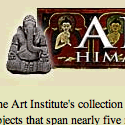|
|
| Show All 80 Results (Text Only) |
|
| Visions of Enlightenment: Arts of Buddhism |

|
| Pacific Asia Museum of USC
|
An excellent site for students, with many additional resources for teachers. Text essays with images on the following four topics: 1) The Perfected One: The Buddha; 2) Compassionate Beings: Bodhisattvas, Deities, Guardians, Holy Men; 3) Buddhist Places; and 4) Signs, Symbols, Ritual Objects. Also features an extensive glossary of Buddhist-related terms and an excellent interactive map and timeline outlining the life of the Buddha and the spread of Buddhism. Teaching unit at the link below. See also Introduction.
Go to Museum Resource: https://pacificasiamuseum.usc.edu/exhibitions/past/exhibitions-at-usc-pam-prior... | |
|
|
| The Art of Asia: Buddhism |

|
| Minneapolis Institute of Arts
|
Provides an excellent short history of Buddhism from India to Japan illustrated with art from the MIA's collection. The four main topics are: 1) Origins of Buddhism; 2) Who's Who in Heaven; 3) Guide to Buddhist Sects; and 4) Guide to the Yamantaka Mandala, which includes a short video documentary of a mandala being created and consecrated. There is also a short video on Japanese Buddhism; eight featured objects, each accompanied by an interview with an MIA curator explaining the meaning of the work; and a glossary.
Go to Museum Resource: http://archive.artsmia.org/art-of-asia/buddhism/ | |
|
|
| The Art of Buddhism |
|
| National Museum of Asian Art, Smithsonian Institution
|
Buddhism arose in an area bordering present-day India and Nepal. As it spread across Asia, the religion both influenced and was influenced by the religious, cultural, and artistic life of the regions it touched. The Freer Gallery of Art and Arthur M. Sackler Gallery house a major collection of Buddhist art, selections of which are on public display. This guide briefly introduces a few key points about Buddhism in India, Tibet, China, and Japan and presents examples of the majestic holdings of Buddhist art in the Freer and Sackler galleries. See also The Art of Buddhism: a Teacher's Guide [PDF].
Go to Museum Resource: https://archive.asia.si.edu/exhibitions/online/buddhism/default.htm | |
|
|
| Life of the Buddha |
|
| The Metropolitan Museum of Art
|
A brief overview of the life of the historical Buddha. With links interspersed throughout the text to 20 artworks from the museum’s collection that illustrate various aspects of the historical Buddha’s life story.
Go to Museum Resource: http://www.metmuseum.org/toah/hd/buda/hd_buda.htm | |
|
|
| Buddhist Art and the Trade Routes |
|
| Asia Society
|
An extensive site, covering three main topics: 1) Trade Routes; 2) Buddhism and its Imagery; and 3) India: Origins of Buddhist Art. Also discusses the Buddhist art of specific regions -- Korea/Japan; China/Mongolia; Himalayas; Southeast Asia; and Sri Lanka. With maps, images, a glossary of terms, and bibliography.
Go to Museum Resource: http://www.asiasocietymuseum.org/buddhist_trade/index.html | |
|
|
| Cave as Canvas: Hidden Images of Worship Along the Ancient Silk Routes |
|
| National Museum of Asian Art, Smithsonian Institution
|
Buddhist Cave Temples in Chinese Central Asia. Buddhism reached Chinese Central Asia (modern Xinjiang) from India around the first century A.D., brought by missionaries via the ancient Silk Routes. By the third century A.D., this new religion was flourishing in all the oasis kingdoms in the Tarim Basin (the Taklamakan Desert), also known as eastern Turkestan. As the Buddhist religion took hold and piety increased, the Indian tradition of excavating caves to serve as Buddhist sanctuaries proliferated in this region. In many of the Central Asian states, monasteries and temples were hewn out of the cliffs in secluded river valleys. With the patronage of local rulers, the elite, and wealthy merchants, these institutions gradually became major Buddhist centers. They continued to grow and prosper until the advent of Islam. Today, such Buddhist rock-cut cave complexes are some of the finest, if little known, monuments preserved in Chinese Central Asia.
Go to Museum Resource: https://archive.asia.si.edu/exhibitions/online/cave/default.htm | |
|
|
| Monks and Merchants: Silk Road Treasures from Northwest China, Gansu and Ningxia, 4th-7th Century |
|
| Asia Society
|
Features more than 35 objects organized into the following topics: 1) Heavenly Horses; 2) Nomadic Rulers; 3) Buddhism and China; 4) Buddhist Cave Temples; 5) Bodhisattvas; 6) Monks; 7) Merchants and Currencies; 8) The Tang Dynasty. Each topic has overview text, and each object is accompanied by short descriptive text. An additional topic on the Silk Road itself gives extensive background information on the geographical, historical, religious, and cultural context of the Silk Road.
Go to Museum Resource: http://sites.asiasociety.org/arts/monksandmerchants/index.html | |
|
|
| Art Access: Art of India, Himalayas, and Southeast Asia |
|
| The Art Institute of Chicago
|
This introduction to the art of South and Southeast Asia features 15 representative objects (mostly Hindu and Buddhist sculptures) from the Art Institute's collection. The objects have good descriptive text with links to an excellent glossary and maps. The site also includes four lesson plans (specifically for grade levels 1-3, 4-8, 7-8, and 9-12, but adaptable for all age groups). Each lesson plan includes a list of the fulfilled Illinois Learning Standards for that plan, and the lesson plan Divine Faith Discussion lists some Buddhist, Hindu, and Islamic places of worship in the Chicago area. There is also a Family Activities section (with hands-on activities for younger children) and a bibliography of books and media.
Go to Museum Resource: https://archive.artic.edu/indian/ | |
|
|
|
| Show All 80 Results (Text Only) |








